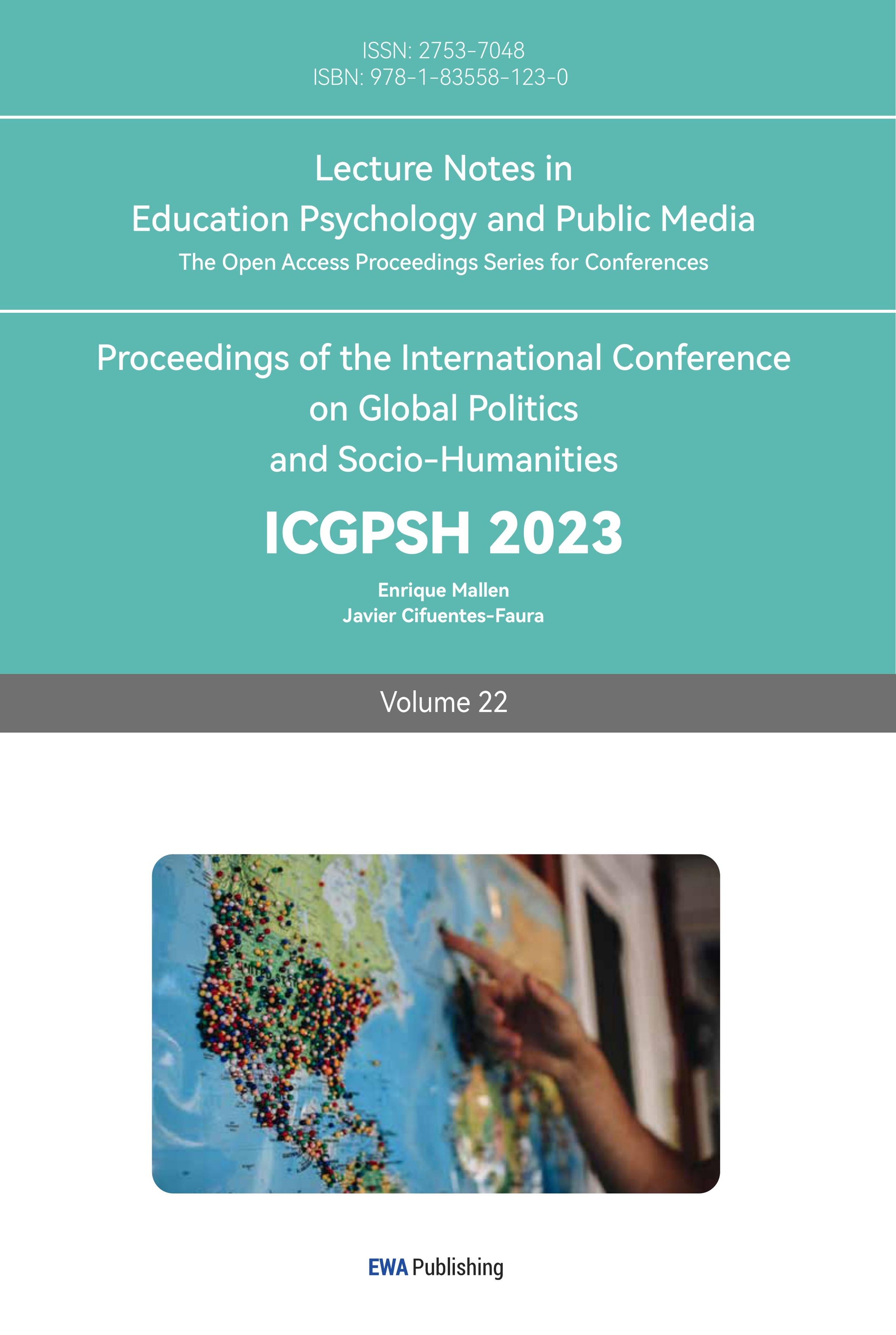References
[1]. Dewaele Jean-Marc & LI Chengchen.(2020).Emotions in second language acquisition:A critical review and research agenda. Foreign language circles (01),34-49.
[2]. Li C. A Positive Psychology Perspective on Chinese Students’ Emotional Intelligence, Classroom Emotions, and EFL Learning Achievement . Xiamen: Xiamen University, 2018.
[3]. Seligman M. E. Flourish: A Visionary New Understanding of Happiness and Well-Being. New York: Free Press, 2011.
[4]. Mercer S & Gkonou C. Teaching with Heart and Soul . In Gregersen T. S &MacIntyre P. D. (eds.). Innovative Practices in Language Teacher Education:Spanning the Spectrum from Intra- to Inter-Personal Professional Development. Cham: Springer International Publishing, 2017. 103-124.
[5]. Daley, S. G., Willett, J. B., & Fischer, K. W. (2014). Emotional responses during reading: Physiological responses predict real-time reading comprehension. Journal of Educational Psychology, 106(1), 132–143.
[6]. Li, C., & Wei, L. (2022). Anxiety, enjoyment, and boredom in language learning amongst junior secondary students in rural China: How do they contribute to L2 achievement? Studies in Second Language Acquisition, 45, 93–108(Second Language Acquisition (2023)), 1–16.
[7]. Al-Khasawneh, F. (2019). The Impact of Vocabulary Knowledge on the Reading Comprehension of Saudi EFL Learners. Journal of Language and Education, 5(3), 24–34.
[8]. Mercer S., MacIntyre P. D., Gregersen T. & Talbot K. Positive Language Education: Combining Positive Education and Language Education . Theory and Practice of Second Language Acquisition, 2018, 4(2): 11-31.
[9]. MacIntyre P. D., Dewaele J.-M., Macmillan N. & Li C. The emotionalunderpinnings of Gardner’s Attitudes and Motivation Test Battery . In MacIntyre P D & Al-Hoorie A (eds.). Contemporary Language Motivation Theory: 60 Years Since Gardner and Lambert (1959). Bristol: MultilingualMatters, 2019. 57-79.
[10]. Stevens, J. S., & Hamann, S. (2012). Sex differences in brain activation to emotional stimuli: A meta-analysis of neuroimaging studies. Neuropsychologia, 50(7), 1578–1593.
[11]. Hauck, P., & Hecht, H. (2023). Emotionally congruent music and text increase immersion and appraisal. PLOS ONE, 18(1), e0280019.
[12]. Zaccoletti, S., Raccanello, D., Burro, R., & Mason, L. (2022). Reading with induced worry: The role of physiological self‐regulation and working memory updating in text comprehension. British Journal of Educational Psychology, 93(Suppl. 1), 26–47(British Journal of Educational Psychology (2023).
Cite this article
Zhang,L. (2023). The Effect of Emotions on Reading Comprehension. Lecture Notes in Education Psychology and Public Media,22,221-227.
Data availability
The datasets used and/or analyzed during the current study will be available from the authors upon reasonable request.
Disclaimer/Publisher's Note
The statements, opinions and data contained in all publications are solely those of the individual author(s) and contributor(s) and not of EWA Publishing and/or the editor(s). EWA Publishing and/or the editor(s) disclaim responsibility for any injury to people or property resulting from any ideas, methods, instructions or products referred to in the content.
About volume
Volume title: Proceedings of the International Conference on Global Politics and Socio-Humanities
© 2024 by the author(s). Licensee EWA Publishing, Oxford, UK. This article is an open access article distributed under the terms and
conditions of the Creative Commons Attribution (CC BY) license. Authors who
publish this series agree to the following terms:
1. Authors retain copyright and grant the series right of first publication with the work simultaneously licensed under a Creative Commons
Attribution License that allows others to share the work with an acknowledgment of the work's authorship and initial publication in this
series.
2. Authors are able to enter into separate, additional contractual arrangements for the non-exclusive distribution of the series's published
version of the work (e.g., post it to an institutional repository or publish it in a book), with an acknowledgment of its initial
publication in this series.
3. Authors are permitted and encouraged to post their work online (e.g., in institutional repositories or on their website) prior to and
during the submission process, as it can lead to productive exchanges, as well as earlier and greater citation of published work (See
Open access policy for details).
References
[1]. Dewaele Jean-Marc & LI Chengchen.(2020).Emotions in second language acquisition:A critical review and research agenda. Foreign language circles (01),34-49.
[2]. Li C. A Positive Psychology Perspective on Chinese Students’ Emotional Intelligence, Classroom Emotions, and EFL Learning Achievement . Xiamen: Xiamen University, 2018.
[3]. Seligman M. E. Flourish: A Visionary New Understanding of Happiness and Well-Being. New York: Free Press, 2011.
[4]. Mercer S & Gkonou C. Teaching with Heart and Soul . In Gregersen T. S &MacIntyre P. D. (eds.). Innovative Practices in Language Teacher Education:Spanning the Spectrum from Intra- to Inter-Personal Professional Development. Cham: Springer International Publishing, 2017. 103-124.
[5]. Daley, S. G., Willett, J. B., & Fischer, K. W. (2014). Emotional responses during reading: Physiological responses predict real-time reading comprehension. Journal of Educational Psychology, 106(1), 132–143.
[6]. Li, C., & Wei, L. (2022). Anxiety, enjoyment, and boredom in language learning amongst junior secondary students in rural China: How do they contribute to L2 achievement? Studies in Second Language Acquisition, 45, 93–108(Second Language Acquisition (2023)), 1–16.
[7]. Al-Khasawneh, F. (2019). The Impact of Vocabulary Knowledge on the Reading Comprehension of Saudi EFL Learners. Journal of Language and Education, 5(3), 24–34.
[8]. Mercer S., MacIntyre P. D., Gregersen T. & Talbot K. Positive Language Education: Combining Positive Education and Language Education . Theory and Practice of Second Language Acquisition, 2018, 4(2): 11-31.
[9]. MacIntyre P. D., Dewaele J.-M., Macmillan N. & Li C. The emotionalunderpinnings of Gardner’s Attitudes and Motivation Test Battery . In MacIntyre P D & Al-Hoorie A (eds.). Contemporary Language Motivation Theory: 60 Years Since Gardner and Lambert (1959). Bristol: MultilingualMatters, 2019. 57-79.
[10]. Stevens, J. S., & Hamann, S. (2012). Sex differences in brain activation to emotional stimuli: A meta-analysis of neuroimaging studies. Neuropsychologia, 50(7), 1578–1593.
[11]. Hauck, P., & Hecht, H. (2023). Emotionally congruent music and text increase immersion and appraisal. PLOS ONE, 18(1), e0280019.
[12]. Zaccoletti, S., Raccanello, D., Burro, R., & Mason, L. (2022). Reading with induced worry: The role of physiological self‐regulation and working memory updating in text comprehension. British Journal of Educational Psychology, 93(Suppl. 1), 26–47(British Journal of Educational Psychology (2023).









